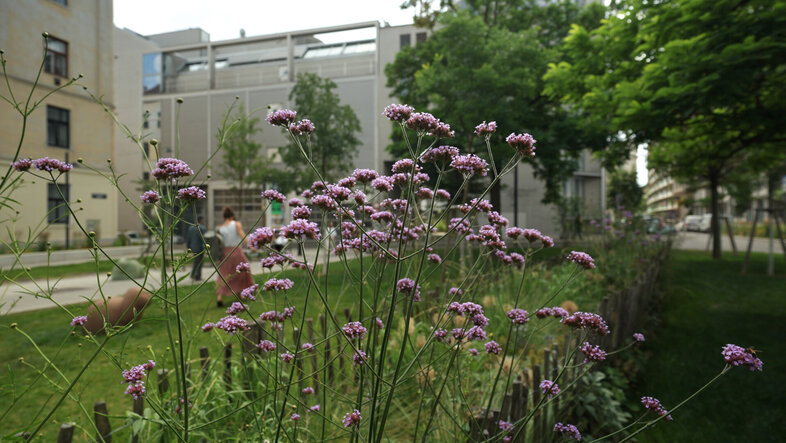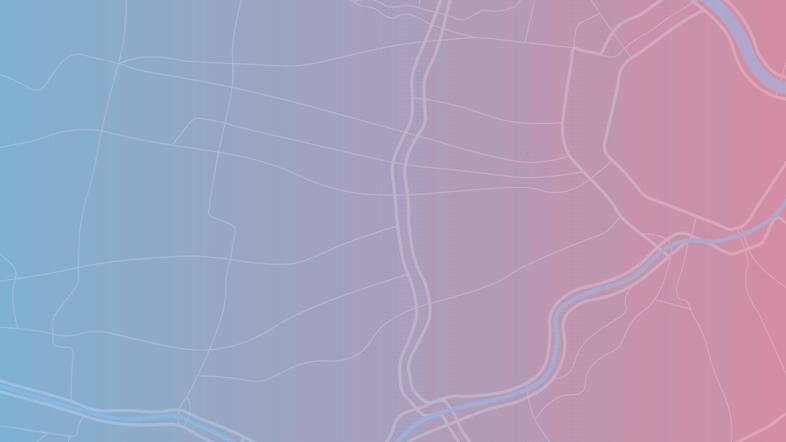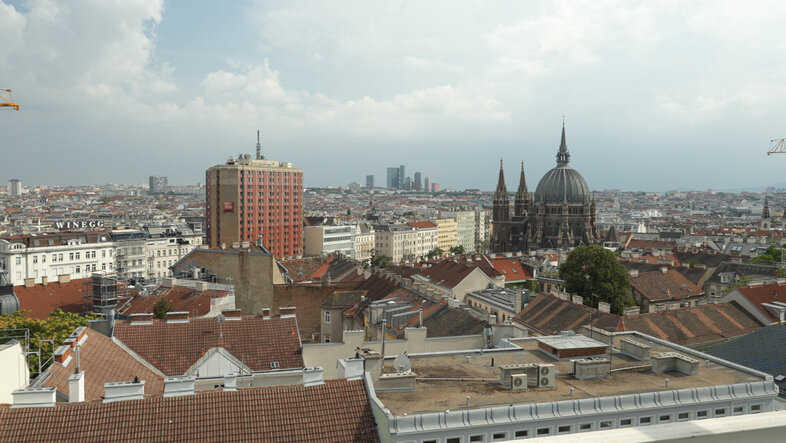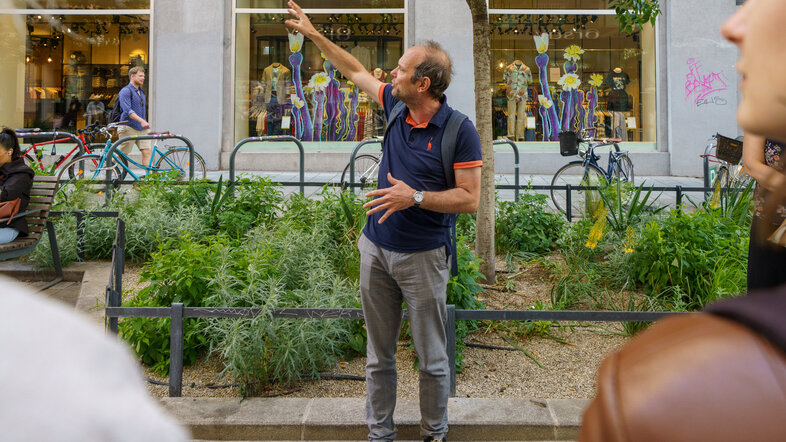Ready for the heat island?
Video: How climate-resilient is Vienna? City walk with Yvonne Franz and Kerstin Krellenberg
Urban heat islands
The summers in Vienna are one thing above all: hot. And they are becoming even hotter. In the 1970s, Austria had seven hot days per year on average. Today, we have 27 - and the number is rising. "Urban areas heat up more than their surrounding areas," explains urban researcher Kerstin Krellenberg from the University of Vienna, "in the city we have more sealed surfaces and a lot of heat-storing material such as asphalt, concrete, metal and glass. Buildings and streets absorb solar radiation, store the energy and release the heat back into the environment, thus creating so-called urban heat islands, which can be up to ten degrees warmer than the surrounding countryside."
Come along on our Summer City Trip!
A tour through Vienna to sense the city: Our researchers Kerstin Krellenberg and Yvonne Franz recommend the following route for anyone who wants to explore urban green oases, temperature differences in the city and current development projects in Vienna on their own:
- Lerchenfelder Strasse: The street will be made fit for the future. Above all, residents want trees, green spaces and less traffic. What do you think could make Lerchenfelder Strasse more attractive?
- Zollergasse: traffic calming measures, unsesaling of surfaces in the area of the planted trees, greenery in the form of Zelkova and, of course, the newly built Zollerbach brook make Zollergasse feel a few degrees cooler than other city centre streets. Feel it yourself!
- Christian Broda Platz: Welcome to the construction site. This will soon look very different. Targeted unsealing will make Christian Broda Platz square more inviting. An important step towards sustainable urban development.
- Millergasse: In this tranquil street, the asphalt has been removed and replaced by paving stones. It already feels different, doesn’t it? In case of heavy rain, the water can be absorbed better than when the surface is completely sealed, and light-coloured stones heat up less than dark asphalt. It is worth taking a little break here under the shady plane tree.
- U3 station Westbahnhof/Helga-Pollak-Kinsky-Park: Wildflowers, trees and seating: a high-quality open space has been created here. What we do not see: Marginalised groups are being displaced by gentrification.
- Amtshaus Rudolfsheim-Fünfhaus: This residential street is for playing, strolling, sitting or passing quickly. Many different urban stakeholders meet here and involving them is particularly important in sustainable urban development.
How to get the GPS track:
Download the GPX file below to your smartphone and import it into the navigation app of your choice, such as Komoot. Here you can find instructions for importing it into Komoot.
Suggested route for your Summer City Trip through Vienna
When the heat becomes a problem
Krellenberg is working at the Department of Geography and Regional Research on the effects of increasing heat. She is cooperating with various urban stakeholders from politics, administration, the private sector and civil society. Vienna is thus becoming an urban laboratory where experiments are carried out together and locals are given a voice to develop innovative solutions for our cities. The heat is becoming a problem, especially for those who live in densely built-up areas and in insufficiently insulated buildings or have no cooling green spaces in their neighbourhoods, "but in principle for everyone who encounters asphalt and concrete without shade in public spaces," says Krellenberg.
The Climate Walk group has reached Lerchenfelder Strasse street in the meanwhile. Concrete and asphalt blaze in the heat, participants gather around the public drinking fountain and fill their water bottles. They listen to urban psychologist Addi Walla from "STADTpsychologie", who is working on a City of Vienna project to change Lerchenfelder Strasse street. "The aim is to redesign the street as part of a participatory process. Among other things, residents want more trees, lots of greenery and traffic calming." People and the environment are often mistakenly seen as opposites, but urban and environmental psychology are interested in the interplay between the two. "After all, a city does not just consist of buildings and streets. What really defines it are the people who live in it," adds Walla.
"Shade is for the rich"
The city walk through Vienna is a joint initiative of the Environment and Climate Research Hub (ECH) of the University of Vienna and the Climate Walk Austria association, whose members have already walked across Europe to raise awareness of the climate crisis and to engage in dialogue with local stakeholders. "Someone in Brussels once told us that 'shade is for the rich'", remembers Eva Holzinger from Climate Walk Austria. What is the situation in Vienna? Who is "allowed" to live in the shade?
Urban geographer Yvonne Franz from the University of Vienna, who specialises in cooperative urban development in Vienna, provides the answer. "The Gürtel beltway was originally a dividing line between privileged residential areas in the city centre and neighbourhoods in the historic suburbs of Vienna, where socio-economically disadvantaged people lived. This has changed in recent years," says Franz. "Vienna's districts are now closely connected and the city is initiating many development projects. For example, a high-quality open space was created on the forecourt of the Westbahnhof railway station together with an international furniture company – now there are wildflowers, trees and seating. But what we do not immediately see is the displacement of marginalised groups through gentrification, i.e. the process of transforming a neighbourhood from low value to high value. For example, what about people who are homeless and spend their leisure time outdoors? They are often not wanted in the newly created cooling zones. There is no room for them there any longer."
Sensing the city on the Climate Walk
The walk through the city sharpens our senses: We experience how different building materials feel, how green spaces and trees cool the city, how targeted cooling measures change the perception of heat and that we are still far away from climate justice. Summer is the best time for a Climate Walk: Join Yvonne Franz and Kerstin Krellenberg on 8 August 2024 on a walk across Vienna (in German) or head out on your own. (hm)
Climate Walk on 8 August: "Vienna - It's getting hot in here!" (fully booked)
How do the different building materials feel? Where is Vienna a few degrees cooler? And what about climate justice in Vienna? On Thursday 8 August at 4 pm, the Rudolphina Summer City Trip will once again give you the chance to explore (your own) city with experts.
The route runs from Karlsplatz to the "Cool Zone" in Gumpendorferstraße and a refreshing surprise awaits all participants to guarantee a cool down. Yvonne Franz and Kerstin Krellenberg from the Institute of Geography and Regional Research will be your guides. The Climate Walk is organised by the Research Association Environment and Climate (ECH) of the University of Vienna in cooperation with the Climate Walk Austria association.
- The date on 8 August is unfortunately already fully booked. You can find our suggested route for a follow-up walk in the info box at the top of the text.
- Here you can find all information about upcoming events and offers of the Research Network Environment and Climate (ECH) of the University of Vienna.
Her research focuses on the impacts and challenges of global environmental change on urban areas and the solutions needed for adaptation, resilience and transformation.
- The Rudolphina Summer City Trip at a glance
- Environment and Climate Research Hub of the University of Vienna
- Department of Geography and Regional Research at the Faculty of Earth Sciences, Geography and Astronomy
- Urban Sustainability Living Lab
- Postgraduate Master's degree "Cooperative Urban and Regional Development" at the University of Vienna







